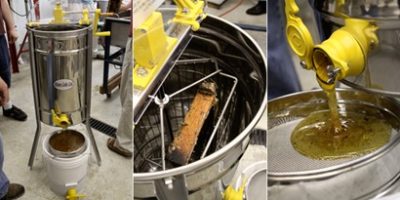How Honey is Made
The simplified version...

01. Flowers produce nectar and attract the bees

02. Bees collect the nectar and carry it to the beehive

03. When full, bees seal honey cells with wax

04. I collect the honey, package it, and sell it
Now the Nitty, Gritty Details
Bees making honey is a fascinating process. The methods and tools that they use to make it give glory to our Creator and His intelligent design. Before the bees can make the honey, itself they must create the comb to store it. They use a hexagon because it is one of the strongest and most efficient shapes in the natural world. To create the comb they excrete scales of pure beeswax out of their abdomens, chew them up, and then form them into the comb.
The foragers leave the hive in search of nectar. When they find a good flower source, they come back and communicate its location to other bees through a special dance called a waggle dance. In this dance they move in a figure 8 pattern, while wiggling their abdomen to show the location and the distance.
 Once the bees know where to go, the other foragers will go and collect nectar. The nectar they collect goes into their honey stomach, where an enzyme called invertase is mixed through to start the process into making it into honey. Once back at the hive, they pass the nectar from bee to bee, through regurgitation. This begins the process of slowly drying it out before storing it. Once the nectar gets to its destination the bees will put it into a cell and allow it to dry out until it gets to under 18% water. Then they will cap off this honey with beeswax.
Once the bees know where to go, the other foragers will go and collect nectar. The nectar they collect goes into their honey stomach, where an enzyme called invertase is mixed through to start the process into making it into honey. Once back at the hive, they pass the nectar from bee to bee, through regurgitation. This begins the process of slowly drying it out before storing it. Once the nectar gets to its destination the bees will put it into a cell and allow it to dry out until it gets to under 18% water. Then they will cap off this honey with beeswax.
The honey stays in these cells until it is used to feed the larvae or until the I come and take it out of the hive. When I remove it from the hive, I take it to where I will extract the honey, sometimes called a honey house. I then use a hot knife to remove the wax. Next, I place the frames into an extractor. This device spins the honey out of the frames and allows it to drain out the bottom through a spout. After this I gently strain it before bottling and packaging.
